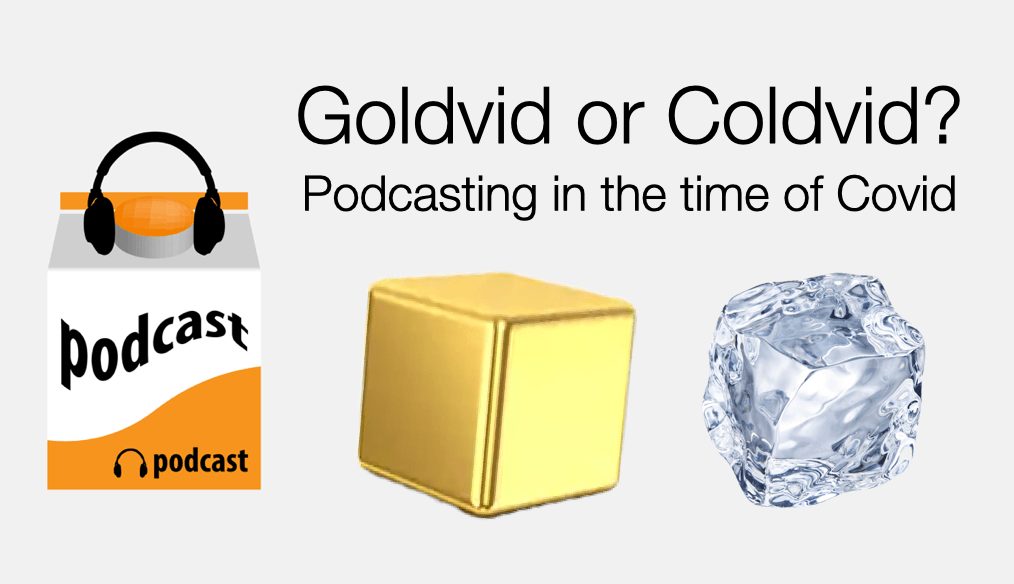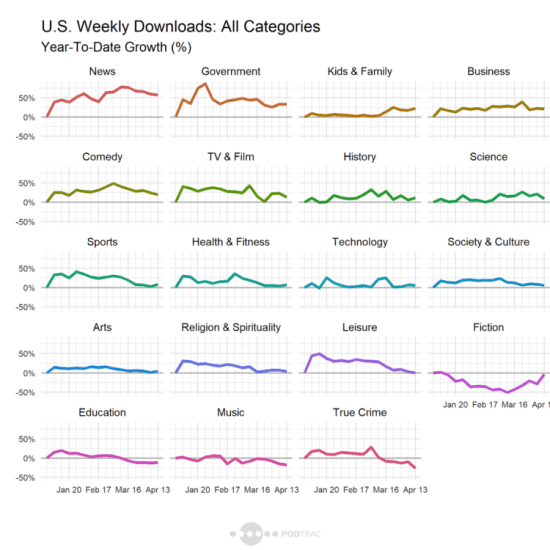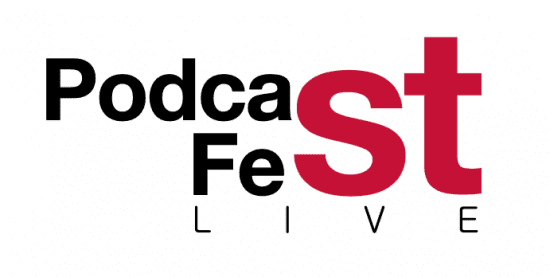With an estimated third of the planet’s population under some form of restriction (up to lockdown) mostly in the First World, many people are looking at the option of podcasting. It feels like a veritable podrush! And it makes sense given that a podcast is almost exactly “social distancing” in that it allows for asynchronized and personable communications at a distance. As I like to say, we ought to be practising not social distancing, but social proximity & physical distancing.
From anecdotal evidence, such as friends contacting me about how to start a podcast, I felt from the outset that there might be a goldrush to podcasting, so much so that I wrote a blog post on the topic (“How To Set Up A Podcast“). At the same time, I’ve seen that my podcast monthly downloads have decreased by about 25% in the month of April. Meanwhile, signups for my newsletter and traffic on my blog are both up considerably versus average. Surely, needs and behaviours have been shifting.
Surging supply of podcasts
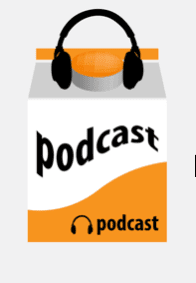
Starting up a podcast from the confines of your home office is relatively simple. Assuming you have a quiet enough space, a modicum of equipment and a subject you’d like to air, go for it, I say. To wit, Apple announced on April 21 that Apple Podcasts is available in 20 more countries and that the number of podcasts has risen to over 1 million active shows. That number compares to the 850,000 cited as recently as March 2020 (see my State of the Podcast 2020). Ergo, about 193,000 nascent podcasts in the last three months. [Source]
Countervailing Supply & Demand
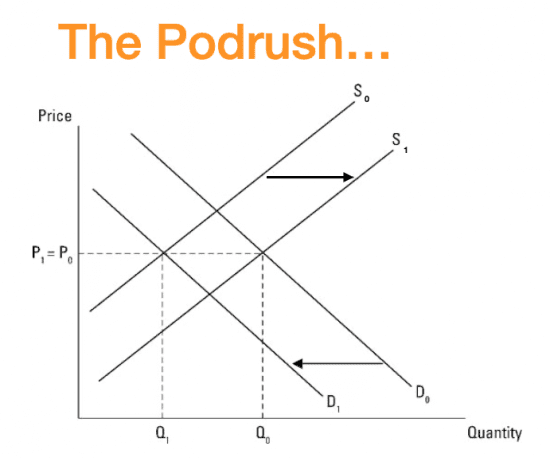
If supply is bulging, on the consumption (“demand”) side the data isn’t as positive. A WWD article from end of March, citing Podtrac stats, stated that, compared to the start of that month, downloads were down 10% and total unique listeners had dropped about 20%. Clearly, the absence of people commuting to/from work has penalized consumption. I surmise that the lack of access to a gym and restrictions on running and walking have also restrained podcast listening. The decline was across the board in terms of categories, although news-related podcasts dropped less. A more recent post from Podtrac has shown, however, that consumption is coming back, albeit differently.
Weekly downloads as measured year-to-date (i.e. from the first week of January) are up 20% as of April 20, and weekly audience is +4%. Interestingly, in terms of changing behaviours, peak podcast downloads on Saturday and Sunday were up 9% and 20% respectively. Of note, on the set of shows that Podtrac measures, the download growth year-to-date for top podcast categories were: +57% for News, +20% for Business, +20% Comedy, +8% for Sports, and 6% Society & Culture (through the week ending April 19). The below graphic from Podtrac on US YTD downloads per category shows a wide variety of results. For example, fiction nose-dived and is now coming back. Education, music and true crime trended worse than most other categories. News and Government related podcasts have shown the best growth.
@FindThatPod wrote, based only on anecdotal evidence: “It seems that overall podcast consumption is down around 15-20% overall, but only on weekdays. Weekends seem to remain roughly the same. Seems like a high correlation to lack of commuting, at least in the U.S / Canada.” Using hard data from Marco Arment, the creator of my favourite podcast service, Overcast, he confirmed, in an April 7 tweet, that downloads were down 20% during the weekdays, but weekends are unchanged, albeit from a lower base (about 30% lower than weekdays). Arment tweeted that the trend continues as such.
Alban Brooke, head of Marketing at Buzzsprout (the podcast service I use) tweeted to me that “the average podcast saw a drop of 10-15% right after the shutdown orders came in. Most have bounced back to -5% as people found new habits to listen.”
Another feature of consumption, Brooke tweeted, was that more people are now listening to podcasts via their computers as opposed to smartphones. This makes sense given that we’re all rather sedated at home, probably jumping in and out of zoom calls.
Podcast production in time of Covid
So, podcast production is on the rise. Who’s winning in the podrush? This site MyPodcastReviews has a great series of data on produced podcasts (drawn from Apple Podcasts). It’s nicely presented, showing what’s going in terms of additions and removals, active versus inactive and episodes per feed.

Bindi Heit, who runs the Ethical Change Agency (from Australia) and hosts a podcast, Ethical Evolution, wrote: “Since COVID-19 took hold, I have noticed our conversations have changed in podcast interviews globally, because our perspectives have shifted to be more meaningful, full of purpose and change for good.”
Relevancy is (always) key

Podcasts that are adapted to this period, like helping people get to relax or sleep, should do better than the podcasts that tout irrelevant services, products or live sporting events, as examples. The host of the popular Sleep With Me podcast (which has 3 million monthly downloads), Drew Ackerman, told me that, after an initial drop in March, his podcast downloads are back to flat. The newborn Goodnight Podcast that also helps putting people to sleep and which launched end of February 2020, is already getting well over 100 downloads per night (best was over 600 in one day!) which is remarkable for a new show in a crowded space.
One has to imagine that the podcasts that fit the current climate will do better, at least during the crisis. Content that is tone deaf will presumably cause a quick switch off, if not a negative tweet. But, it’s not because you’ve created a podcast with perfectly relevant content, that it’ll shoot through the roof in downloads (unless you’ve already got an established following or access to main stream media). And the challenge will be in making sure the relevancy remains as the context shifts.
“What matters in this period is to remain relevant.”
As Simon Sapper (UnionDues) wrote to me, “Enthusiasm for your new podcasting idea shouldn’t blind you to the need to building an audience. Just because you are enthralled by the prospect of sharing your passion on easy-to-access platforms … you need a clear-eyed view about who your audience is and how you will reach them. In this podcasting-glut period, it is hard to stand out, and you risk creating nothing more than a vanity product, listened to by only your mates and family!” As Heit wrote, what matters in this period is to remain relevant. If nothing else, this may be an enduring lesson for all podcasters, actually all the time!
The bottom line for this podrush?
So, the bottom line about podcasting in the era of Covid-19, supply is up markedly, but demand is down. And there’s presumably quite a lot of switching going on too, as people seek out podcasts that are more appropriate for their needs. Those podcasts that have content that people are thirsting for will do much better. For the podcasts that haven’t adjusted their tone (or content) to be more contextually relevant, they are going to suffer.
So, what are the podcasts that you are turning to in this period? Please do write in your comments and thoughts and share the podcasts that have been heaven-sent during this Covid-19/Coronavirus period.
Come join the Podcast Festival Online
If you enjoyed this article, I’d like to invite you to check out the online conference, the Podcast Festival Live, I am running along with my two partners, Sam Sethi and Andrew Grill. The theme is “The Future of Podcasting.” It will be May 28th, 2020.
***If you like my writing and are interested in fostering more meaningful conversations in our society, please check out my Dialogos Substack. This newsletter will feature articles on why and how we can all improve our conversations, whether it’s at home, with friends, in society at large or at work. Subscription is free, but if you see value in it, you are welcome to contribute both materially and through your comments. Sign up here:

